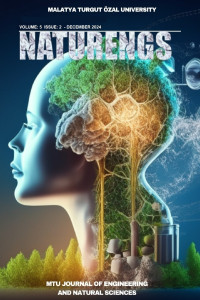Öz
Kaynakça
- Rockey, D. C. (2005). Gastrointestinal bleeding. Gastroenterology Clinics, 34(4), 581-588.
- Kiziloluk, S., Yildirim, M., Bingol, H., & Alatas, B. (2024). Multi-feature fusion and dandelion optimizer based model for automatically diagnosing the gastrointestinal diseases. PeerJ Computer Science, 10, e1919.
- Bhatt, D., Patel, C., Talsania, H., Patel, J., Vaghela, R., Pandya, S., ... & Ghayvat, H. (2021). CNN variants for computer vision: History, architecture, application, challenges and future scope. Electronics, 10(20), 2470.
- Bingol, H. (2022). Classification of OME with Eardrum Otoendoscopic Images Using Hybrid-Based Deep Models, NCA, and Gaussian Method. Traitement du Signal, 39(4).
- Pannu, H. S., Ahuja, S., Dang, N., Soni, S., & Malhi, A. K. (2020). Deep learning based image classification for intestinal hemorrhage. Multimedia Tools and Applications, 79, 21941- 21966.
- Access Date: 05.09.2024, https://data.mendeley.com/datasets/8pbbjf274w/1
- Khan, Ali; Malik, Hassaan (2023), “Gastrointestinal Bleeding WCE images Dataset”, Mendeley Data, V1, doi: 10.17632/8pbbjf274w.1
- Krizhevsky, A., Sutskever, I., & Hinton, G. E. (2012). Imagenet classification with deep convolutional neural networks. Advances in neural information processing systems, 25.
- Kiziloluk, S., Sert, E., Hammad, M., Tadeusiewicz, R., & Pławiak, P. (2024). EO-CNN: Equilibrium Optimization-Based hyperparameter tuning for enhanced pneumonia and COVID- 19 detection using AlexNet and DarkNet19. Biocybernetics and Biomedical Engineering, 44(3), 635-650.
- Szegedy, C., Liu, W., Jia, Y., Sermanet, P., Reed, S., Anguelov, D., ... & Rabinovich, A. (2015). Going deeper with convolutions. In Proceedings of the IEEE conference on computer vision and pattern recognition (pp. 1-9).
- Xia, X., Xu, C., & Nan, B. (2017, June). Inception-v3 for flower classification. In 2017 2nd international conference on image, vision and computing (ICIVC) (pp. 783-787). IEEE.
- Sandler, M., Howard, A., Zhu, M., Zhmoginov, A., & Chen, L. C. (2018). Mobilenetv2: Inverted residuals and linear bottlenecks. In Proceedings of the IEEE conference on computer vision and pattern recognition (pp. 4510-4520).
- You, Y., Zhang, Z., Hsieh, C. J., Demmel, J., & Keutzer, K. (2018, August). Imagenet training in minutes. In Proceedings of the 47th international conference on parallel processing (pp. 1-10).
Öz
Gastrointestinal (GI) diseases are various disorders related to the digestive system. This system includes the esophagus, stomach, small and large intestines, liver, gallbladder and pancreas, starting from the mouth. Early diagnosis is very important in the treatment of the disease. The earlier the disease is diagnosed, the higher the chance of the patient being treated. In recent years, it is known that artificial intelligence techniques have been widely used in disease diagnosis and classification. Among the artificial intelligence techniques, deep learning methods that produce very successful results in image classification are frequently used. This success of deep learning methods has been tried to be used in the classification of GI diseases. Within the scope of this study, it was tried to detect bleeding GI or lesions from publicly available wireless capsule endoscopy (WCE) images. As a result of the experiments, 5 different deep learning architectures were used. Features were extracted from the two architectures that showed the highest accuracy and were combined. Neighborhood Component Analysis (NCA) dimension reduction method was applied to the obtained feature map and a hybrid model was obtained. It was seen that the proposed hybrid model achieved an accuracy value of 86.3%.
Anahtar Kelimeler
Gastrointestinal bleeding Artificial intelligence Deep learning Classification
Kaynakça
- Rockey, D. C. (2005). Gastrointestinal bleeding. Gastroenterology Clinics, 34(4), 581-588.
- Kiziloluk, S., Yildirim, M., Bingol, H., & Alatas, B. (2024). Multi-feature fusion and dandelion optimizer based model for automatically diagnosing the gastrointestinal diseases. PeerJ Computer Science, 10, e1919.
- Bhatt, D., Patel, C., Talsania, H., Patel, J., Vaghela, R., Pandya, S., ... & Ghayvat, H. (2021). CNN variants for computer vision: History, architecture, application, challenges and future scope. Electronics, 10(20), 2470.
- Bingol, H. (2022). Classification of OME with Eardrum Otoendoscopic Images Using Hybrid-Based Deep Models, NCA, and Gaussian Method. Traitement du Signal, 39(4).
- Pannu, H. S., Ahuja, S., Dang, N., Soni, S., & Malhi, A. K. (2020). Deep learning based image classification for intestinal hemorrhage. Multimedia Tools and Applications, 79, 21941- 21966.
- Access Date: 05.09.2024, https://data.mendeley.com/datasets/8pbbjf274w/1
- Khan, Ali; Malik, Hassaan (2023), “Gastrointestinal Bleeding WCE images Dataset”, Mendeley Data, V1, doi: 10.17632/8pbbjf274w.1
- Krizhevsky, A., Sutskever, I., & Hinton, G. E. (2012). Imagenet classification with deep convolutional neural networks. Advances in neural information processing systems, 25.
- Kiziloluk, S., Sert, E., Hammad, M., Tadeusiewicz, R., & Pławiak, P. (2024). EO-CNN: Equilibrium Optimization-Based hyperparameter tuning for enhanced pneumonia and COVID- 19 detection using AlexNet and DarkNet19. Biocybernetics and Biomedical Engineering, 44(3), 635-650.
- Szegedy, C., Liu, W., Jia, Y., Sermanet, P., Reed, S., Anguelov, D., ... & Rabinovich, A. (2015). Going deeper with convolutions. In Proceedings of the IEEE conference on computer vision and pattern recognition (pp. 1-9).
- Xia, X., Xu, C., & Nan, B. (2017, June). Inception-v3 for flower classification. In 2017 2nd international conference on image, vision and computing (ICIVC) (pp. 783-787). IEEE.
- Sandler, M., Howard, A., Zhu, M., Zhmoginov, A., & Chen, L. C. (2018). Mobilenetv2: Inverted residuals and linear bottlenecks. In Proceedings of the IEEE conference on computer vision and pattern recognition (pp. 4510-4520).
- You, Y., Zhang, Z., Hsieh, C. J., Demmel, J., & Keutzer, K. (2018, August). Imagenet training in minutes. In Proceedings of the 47th international conference on parallel processing (pp. 1-10).
Ayrıntılar
| Birincil Dil | İngilizce |
|---|---|
| Konular | Bilgisayar Sistem Yazılımı |
| Bölüm | Research Articles |
| Yazarlar | |
| Yayımlanma Tarihi | 30 Aralık 2024 |
| Gönderilme Tarihi | 15 Ekim 2024 |
| Kabul Tarihi | 26 Kasım 2024 |
| Yayımlandığı Sayı | Yıl 2024 Cilt: 5 Sayı: 2 |


